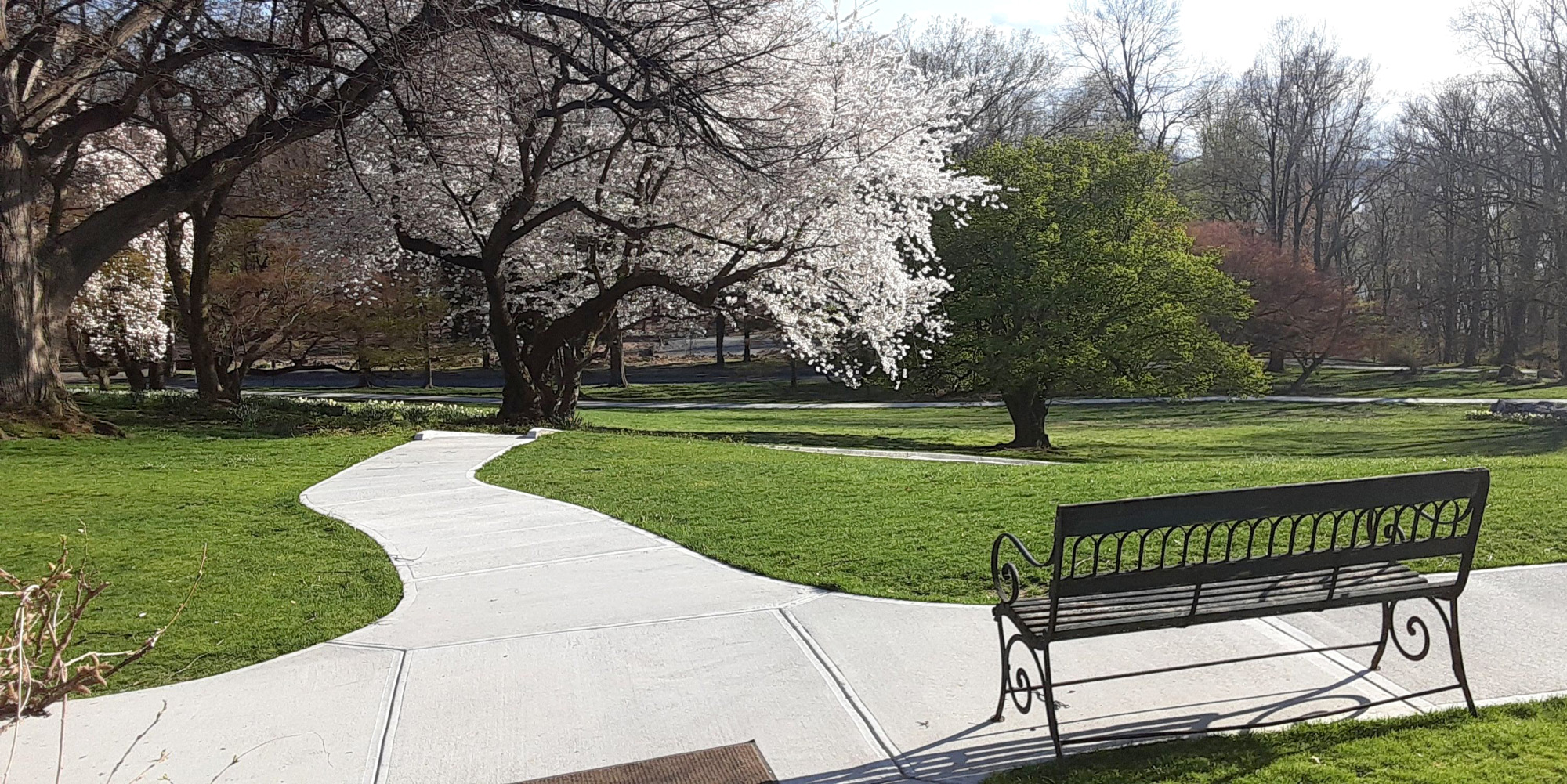Meandering Through Lyndhurst
While our offices are closed and all our programming has been suspended, Lyndhurst has been in a unique position to offer its 67-acre parkland as a place of respite and beauty during this pandemic. This is in keeping with Lyndhurst’s history. Lyndhurst was likely constructed in response to the 1832 cholera epidemic in New York City when half the residents fled to the countryside. During World War II, Anna Gould, Duchess of Talleyrand, used Lyndhurst as a place of respite for soldiers from the Brooklyn Navy Yard and the convalescence buildings on the Lyndhurst property were known to sailors as “Club Lyndhurst.”
Lyndhurst is a place our neighbors can responsibly access via the Old Croton Aqueduct State Park and the Westchester RiverWalk. On nice days, we’re seeing the type of foot traffic that we typically might only see on a summer weekend. Luckily, Lyndhurst is so large that we can accommodate many people comfortably while still social-distancing. We also want to remind our neighbors that, as always, dogs are welcome.
Our Work is Ongoing
Because half of the Lyndhurst staff lives on property and are dedicated to maintenance and landscape work, working from home still means working on the property. A lot of interior work had been completed just before we needed to suspend activities and most of our landscape work has continued unabated. For veteran Lyndhurst walkers who have enjoyed our trails before, you’ll notice quite a bit of activity in the landscape, along new pathways and at the swimming pool building. Here’s what we’ve been able to accomplish:
New County Park Pathway Opened
Those who walk the Old Croton Aqueduct to Lyndhurst from the south will notice a new woodland pathway that is part of the Westchester RiverWalk trail system and leads from the Aqueduct State Park to the new Lyndhurst lower landscape pathways. Just prior to suspension of activities at Lyndhurst, new bollards and signage were placed at the path entries and the pathway was open to visitors. The path follows an existing historic drive that provided vehicular access to four estates, now gone, that used to sit immediately to the south of Lyndhurst. Remnants of those estates, including a stone-lined circular swimming pool, a gatehouse foundation and pachysandra beds from the 1920s, can be seen during visitors’ walks. A native meadow mix has been seeded into areas around the pathway and as trees leaf out with the spring walking, this part of the pathway will feel like a walk in the forest.
Pear Orchard Being Planted
The recreation of a pear orchard is part of our lower landscape restoration. This orchard is shown on the 1873 estate map and restoring this orchard, along with our existing apple orchard and the future restoration of our kitchen garden, will allow us to highlight the use of the landscape to grow food for the residents of Lyndhurst mansion. The orchard is made up of heirloom varieties common to New York State that include a mix of pears intended for immediate eating, cooking and canning, or extremely hard pears that could overwinter in cold storage. The orchard is being planted with deer fencing and ground cover being installed and planting to follow. Fruit trees come as very small bare root plants, so it will take some time until these trees show their full magnificence. The orchard can best be viewed from the main rockery bench.
Camperdown Elm Waiting to be Replanted
Historically, a magnificent weeping elm tree was planted along the pathway between the second and third rockery. The tree was surrounded by a hexagonal bench and likely provided views of the river and the pear orchard. The bench has been constructed and will be replanted at Lyndhurst this season. This rare tree has been growing at a local nursery waiting to be planted at Lyndhurst. The hexagonal bench has been constructed and painted the same historic green color as other benches at Lyndhurst. In the coming weeks, additional soil will be added along the pathway to provide a level seating area and the tree and bench will likely be installed this month.
Historic Benches Being Constructed
Two wooden benches are being recreated based on historic photographs taken circa 1870. We anticipate that these benches will be completed in May and when done, will be placed in the first and second rockeries. These benches provided shaded seating along the lower landscape pathways. A D-shaped bench was created to encircle a majestic 17th century chestnut tree that was unfortunately lost to a blight early in the 20th century. The green color of the benches is a 19th century historic color based on paint drips that were found on some of the existing rocks in the landscape. In addition to restoring the historic appearance of the estate, the benches will provide additional seating for visitors who are exploring the grounds. We still have one additional bench and the large tree house to recreate. Once these are completed, there will be ample seating along the lower landscape pathways.
Swimming Pool Building in Initial Phase of Restoration
Lyndhurst’s early 20th century swimming pool building, styled as a Roman bath, is the last building on the estate in a state of disrepair. The building is undergoing initial renovations in preparation for a major contemporary art installation. Major elements of repair have been conducted. The roof over the entry has been completely stabilized and the roof over the swimming pool has been made watertight. Roofing supports have been strengthened. Electrical supply and wiring is being installed. The entry vestibule has been given new supports and sub-flooring and the front doors have been restored. Notably, the historic gravel path leading to the front steps and the gravel perimeter around the swimming pool has been re-installed. Weeds and chain link fence have been removed from around the building and new lawn has been restored. Visitors can now peek in through the front door windows and see the entry vestibule and get a sense of what the building will look like when it is more fully restored.
Trees and Shrubs Being Ordered
While we finished installing our new pathways in the lower landscape last year, we are currently planning our first major phase of replanting trees and shrubs in the area. Our objective is to recreate the plantings that appear in historic photographs and maps. Because the property was so extensively documented, we can put back the same species of trees that were originally on the property. Approximately, 80% of the trees and shrubs to be replanted are native species, which will help us to reduce the need for hand care and will create habitat for native fauna.
Taken together, these landscape restorations will result in recreating what these early landscapes would have looked like and how people used them when it was believed that the outdoors and fresh air were curative. Ironically, we have come full circle as we see people coming to Lyndhurst for a safe respite and to enjoy nature without jeopardizing their safety. Our community is availing itself of these landscape improvements during a time when passive outdoor recreations is one of the few safe distractions.
We’re Preparing for the Day We Can Reopen
We invite you to take a restful walk through Lyndhurst in the coming weeks to see some of the progress we’re making. Some of the work you won’t see is the activity of our staff, who are working from home and preparing two exhibitions that will open as soon as allowable. As noted above, the swimming pool building will be the site of Watershed, a contemporary art installation and the first public use of the swimming pool building for a Lyndhurst exhibition. In our exhibition gallery, the exhibition Three Parlors: Treasures from the Attic, will highlight pieces of Lyndhurst’s collection that are usually in storage as well as many acquisitions and donations we’ve received over the past five years. A version of this article first appeared in the May issue of ArtsNews, ArtsWestchester’s monthly publication. ArtsNews is distributed throughout Westchester County. A digital copy is also available at artsw.org/artsnews.

